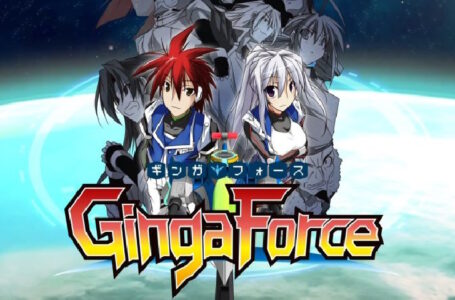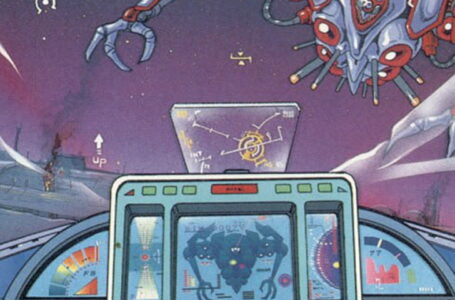Blissful Death: Enjoying Wolflame’s powerful arsenal
One of the best modern developers of shoot ’em ups is Astro Port. This is a company that hasn’t released a ton of games over their lifespan, but everything they have put out has been excellent — and Wolflame is a prime example of them doing what they do best.
Wolflame was originally released for PC in 2016, and was marketed as an homage to classic top-down shoot ’em ups such as Raiden, Twin Cobra and Raptor: Call of the Shadows. More recently, it was ported to Nintendo Switch and released as part of the Shmup Collection alongside its stablemates Armed Seven and Satazius; if you’re a shoot ’em up fan and you have a Switch, this bundle is a superb investment.
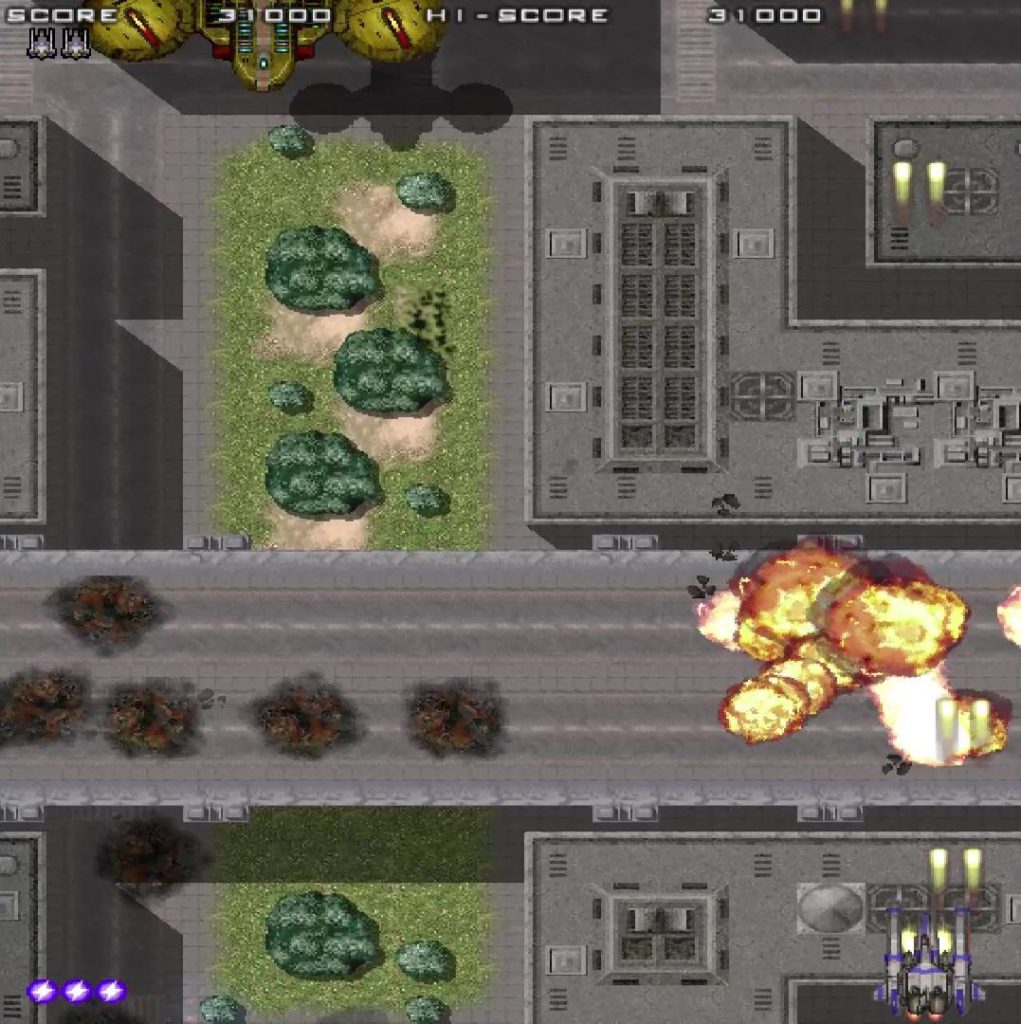
Wolflame is set in the far-off futuristic year of 2005. The Terran colony of Sig Fildonia has been attacked by the vicious Andorians, who wiped out the Terran Defence Force fleet in orbit and commandeered the colony’s facilities to turn them into a sprawling military base. It’s up to you, pilot of the Plinius class corvette “Siebold” to blast off and launch one last desperate attempt at resistance: Operation Wolflame.
None of this matters, of course; the game doesn’t have any sort of cinematic sequences or narrative text, but it’s always nice to know the reason you’re blowing everything up and the context of the backgrounds you’re seeing. In the case of Wolflame, the majority of the action unfolds atop the green fields and blue water of Sig Fildonia — apparently an Earth-like planet, hence, presumably, the reason to colonise it.
Wolflame is a vertical scroller that can optionally be played in Tate mode if you have a suitable setup with which to enjoy it that way. Your craft is initially armed with a forward-firing cannon and a stock of plasma field bombs, but it’s not long before Wolflame demonstrates the main gimmick that makes it stand out among other, similar shooters: its weapons upgrade system.
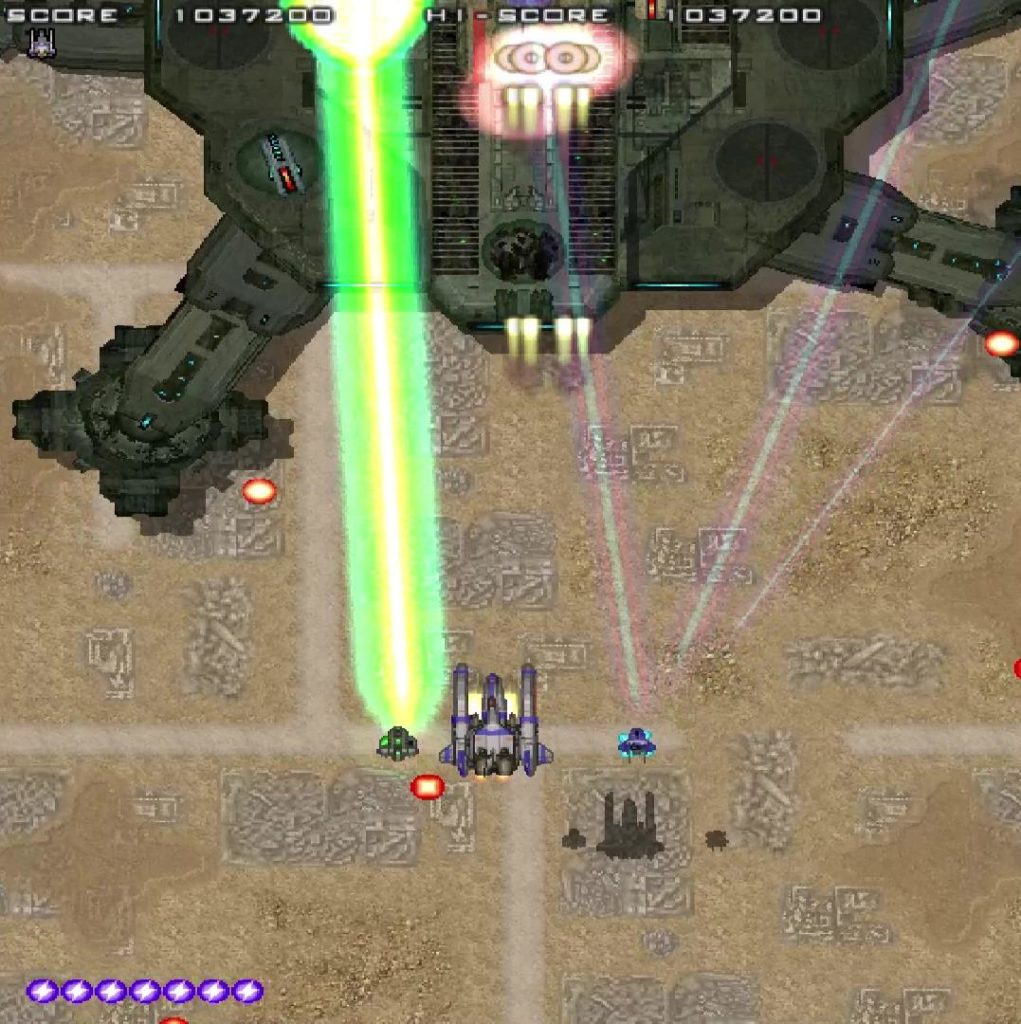
Rather than upgrading your ship’s weapons, collectible power-ups in Wolflame instead take the form of coloured tokens that summon a satellite attack drone on either the port or starboard side of your craft.
When you blast an enemy holding a power-up — which, in true Raiden tradition, is easily identifiable but which takes a bit of effort to blow up — they’ll drop a token with an arrow indicating which side’s satellite it will apply to, and indicating one of three colours. These colours will cycle as the power-up remains on screen, so as long as you’re careful with your timing — and avoiding the enemy bullets — you can set yourself up as you please.
The red power-ups cause your attack drones to act as a spread shot with added homing missiles. The green power-ups cause your attack drones to fire wide, powerful lasers at a slight angle. And the blue power-ups cause your attack drones to fire out thin but powerful blue lasers which can “lock on” to enemies as soon as they make contact.
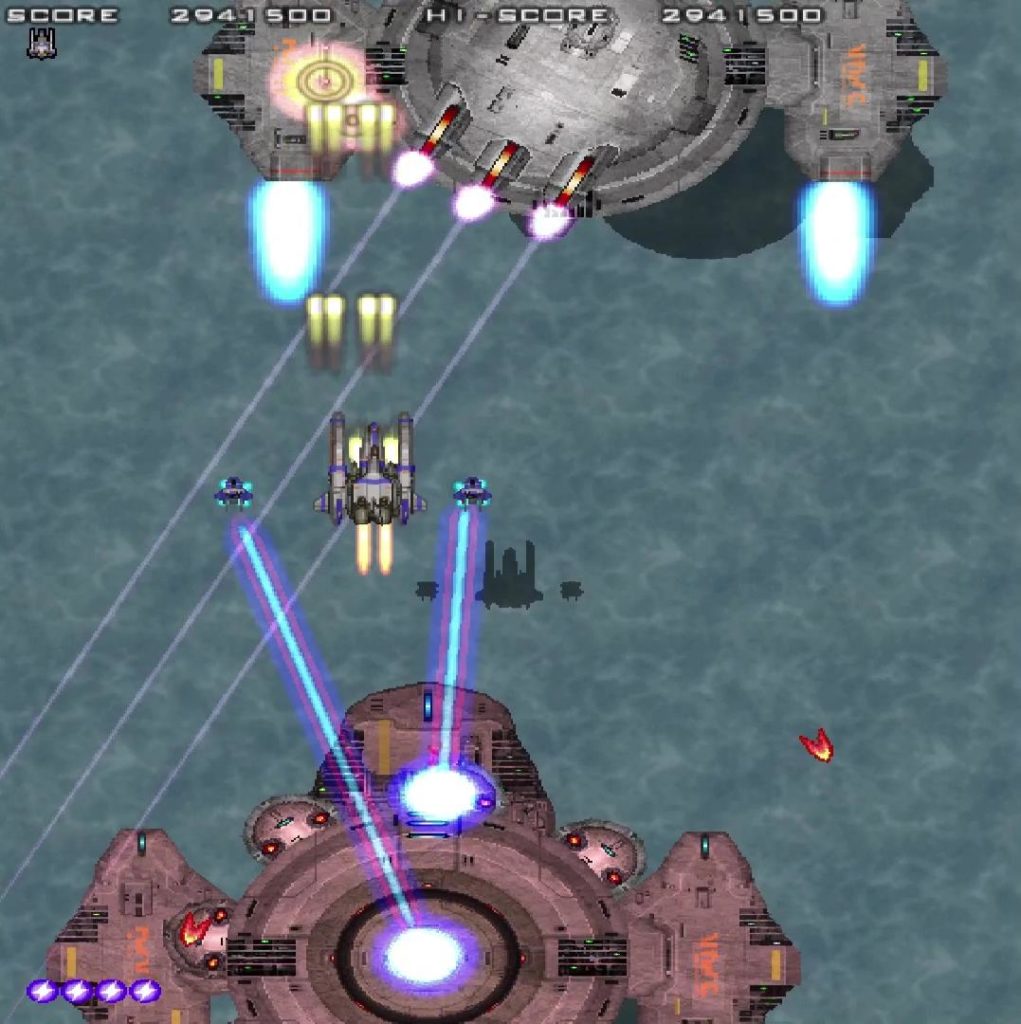
All of these are practical in different circumstances — and the nice thing about each drone being powered up individually is that it means you can mix and match weapon types as you see fit. If you find both the green laser and the spread shot useful, attach one to each side. If you want maximum lock-on potential, go for double blue lasers. If you want the best possible spread of normal shots, go for double red.
You lose all your power-ups and are reset to a checkpoint if you get hit by an enemy or a bullet, but the game isn’t completely mean; shortly after respawning, the next power-up enemy you see will drop a box with a red cross on it. Grab this and you’ll recover all of the power-ups you had before you died, aside from any extra bombs you might have collected. In this way, it’s very rare for you to be left completely defenceless before, say, a challenging boss fight.
Speaking of the boss fights, they’re actually fairly easy, at least on the game’s lower difficulty levels, but most of them do provide plenty of opportunities to blow various parts off the boss prior to finishing them off properly. The blue lasers prove particularly useful in boss encounters, since you can lock them on to the main boss body for continual damage while using your normal shots to destroy turrets and launchers.
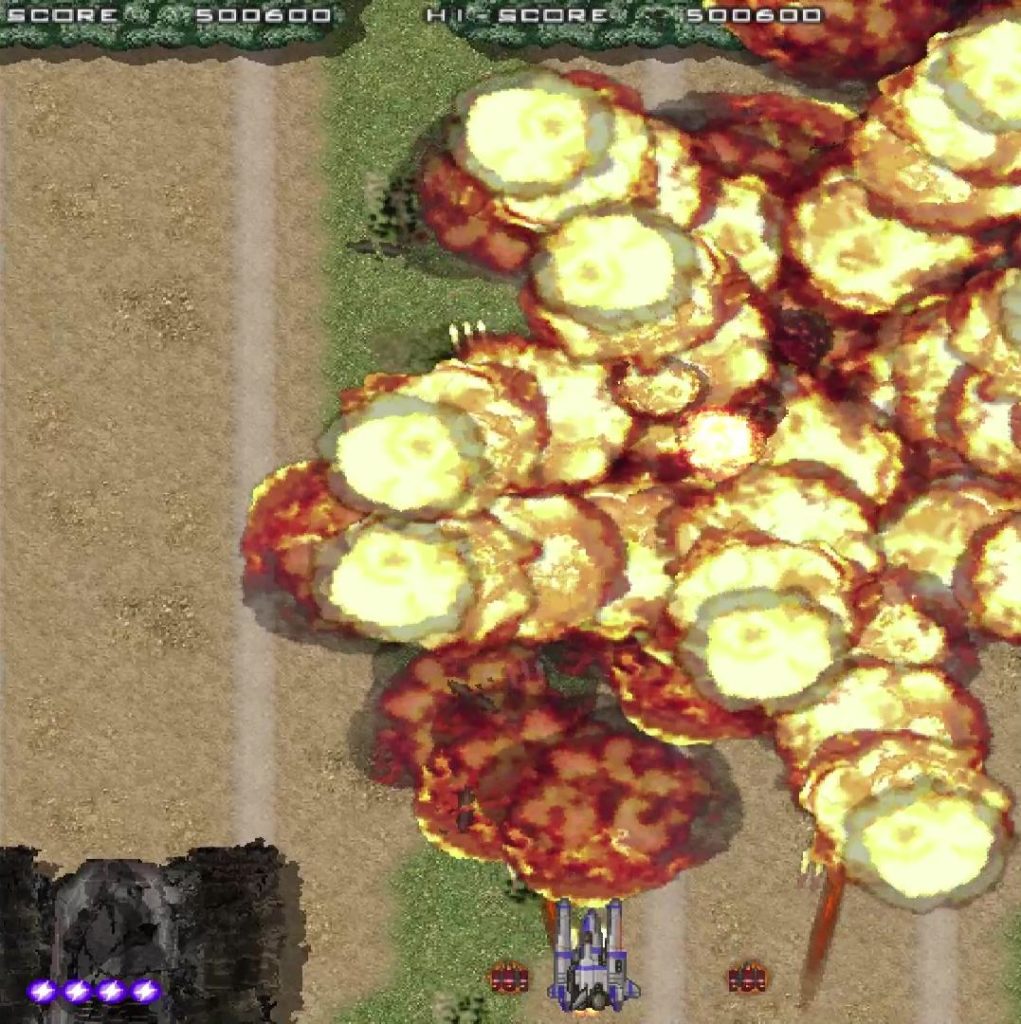
In fact, the game as a whole is pleasingly accessible on its lower difficulty levels, though of course if you bump these up you’ll have a stiff challenge ahead of you. It always feels fair, though; since Wolflame is a shoot ’em up that was originally developed for the home rather than the arcade, it has no need to bait players into credit-feeding their way to the finale.
As such, there’s always the distinct sense that when you mess up it’s your own fault; the game gives you plenty of audio-visual cues about enemy attacks, and it quickly establishes a clear visual language about what types of enemy do what. Repeated playthroughs of the game will allow you to take full advantage of this knowledge and prepare yourself accordingly, and you’ll want to — because this is a game that punishes cockiness to a certain degree.
Some shoot ’em up fans compare Wolflame favourably to Toaplan’s classic shoot ’em ups from over the years, and it’s not hard to see why. Both Wolflame and Toaplan’s games excel in providing straightforward, relatively no-frills shoot ’em up experiences — they’re all about simply engaging with the mechanics, demonstrating your skill and understanding the balance between risk and reward.
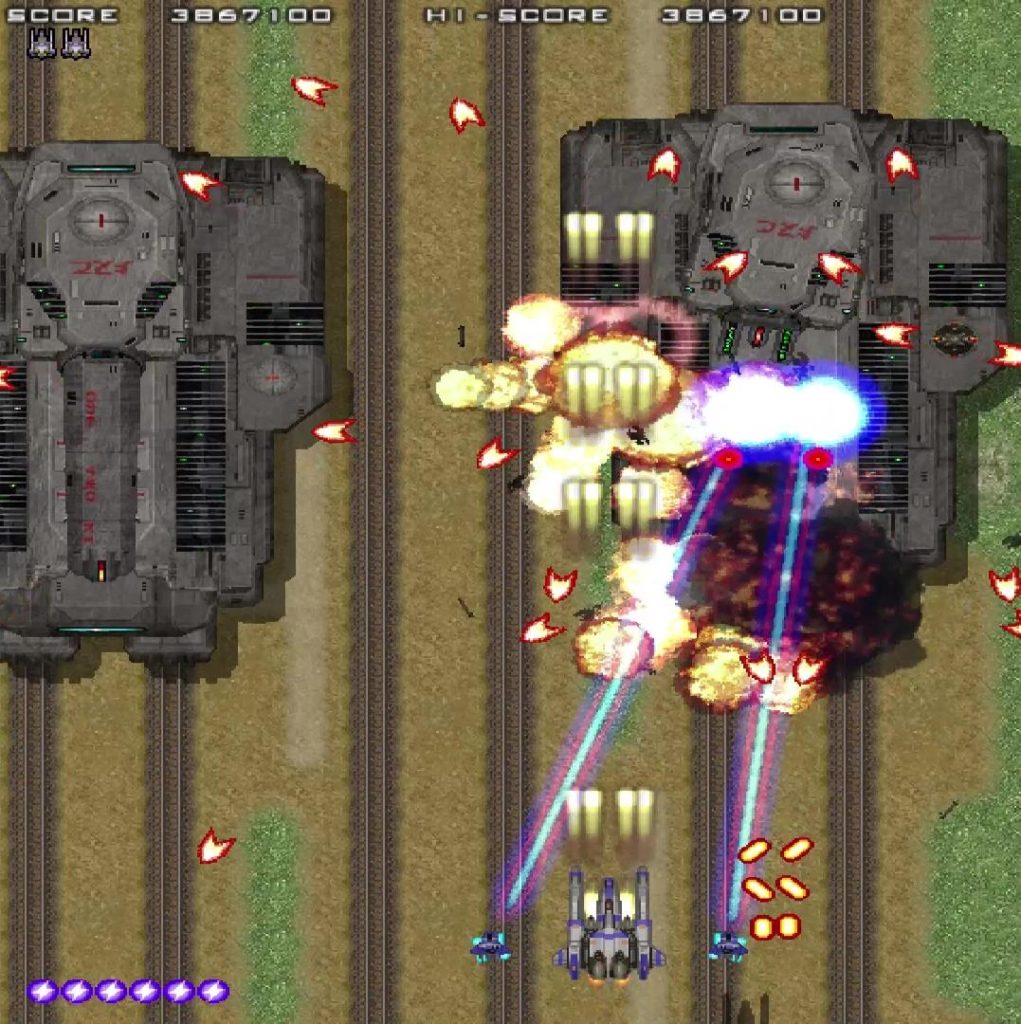
Anything on the map — even a humble tank on the ground — could be the thing that blasts you out of the sky, and so you learn to respect your enemies’ capabilities. Or, well, respect them insofar as you know to blast them as soon as they appear on screen, anyway; a tank that is behind you is a tank that can pop a bullet right up your arse without you noticing, after all.
Like most of Astro Port’s games, Wolflame was obviously developed on a fairly limited budget. Visuals are relatively simple, adopting a relatively high resolution pixel art style that is reminiscent of PC gaming’s first steps beyond 320×200 VGA. The background music is driving but fairly unmemorable, and consists of loops that are shorter than the levels themselves. And some of the sound effects — particularly explosions — are a little weak compared to the all-time classics of the genre. (It should probably be added, however, that the explosion graphics are wonderfully satisfying.)
But what’s really important about Wolflame is that it plays brilliantly. It’s got tight, responsive controls, it’s easy to learn but hard to master — and it’s got that distinct, almost synaesthetic sense of satisfaction that the very best shoot ’em ups inspire in their players.
In other words, while it might not be a shoot ’em up you’d reach for if you’re in the mood for a visual spectacle — this is why we have games like Astebreed, after all. But it’s definitely one you’ll find yourself coming back to again and again when you want something that is simply fun. And ultimately, that’s the really important thing, right?
Join The Discussion
Rice Digital Discord
Rice Digital Twitter
Rice Digital Facebook
Or write us a letter for the Rice Digital Friday Letters Page by clicking here!
Disclosure: Some links in this article may be affiliate links, which means we may earn a small commission if you make a purchase after clicking on them. This is at no additional cost to you and helps support Rice Digital!
- Letter from the Editor: passing the torch - June 30, 2023
- Super Woden GP 2 is looking promising - June 30, 2023
- Inti Creates is making a 32 bit-style Love Live action platformer - June 26, 2023





